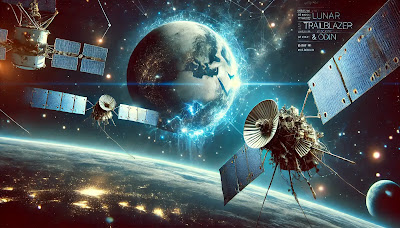Lunar Trailblazer and Odin Spacecraft Face Technical Issues After IM-2 Launch

Introduction
Key Points of the Issue
1. Overview of Lunar Trailblazer and Odin Spacecraft
- Lunar Trailblazer: A NASA-funded spacecraft designed to map water on the Moon and analyze surface hydration, contributing to future lunar exploration and Artemis missions.
- Odin Spacecraft: A research satellite focusing on atmospheric and space weather studies, critical for understanding the space environment.
2. Issues Arising Post-Launch
- Reports indicate communication difficulties and power fluctuations on one or both spacecraft.
- Instruments onboard may not be responding as expected, raising concerns about data transmission and operational status.
3. Possible Causes of the Malfunction
- Launch-Induced Vibrations: Strong mechanical stress during launch may have damaged sensitive components.
- Power System Anomalies: A failure in solar panels or onboard power management could lead to reduced functionality.
- Software or Hardware Glitches: Unexpected software bugs or electronic malfunctions can prevent normal spacecraft operations.
4. Impact on Scientific Objectives
- If unresolved, these problems could hinder lunar water mapping efforts by the Lunar Trailblazer.
- The Odin spacecraft's atmospheric studies could be delayed or compromised.
5. Efforts to Resolve the Issues
- Mission control teams are analyzing telemetry data to diagnose the problem.
- Software updates and remote commands may be used to restore communication or reboot systems.
- Engineers may adjust spacecraft operations to optimize power consumption and extend mission life.
6. Future Implications
- Risk Mitigation for Future Missions: Lessons learned will improve spacecraft designs for resilience against similar failures.
- Backup Strategies for Critical Missions: The importance of redundancy in power and communication systems is emphasized.
Conclusion
While the Lunar Trailblazer and Odin spacecraft face unexpected hurdles, swift action by mission teams could recover their operations. Their success remains vital for lunar exploration and atmospheric research, paving the way for more ambitious space missions.
Update on Technical Challenges Facing Lunar Trailblazer and Odin Spacecraft Post-IM-2 Launch
Following the recent IM-2 mission launch on February 26, 2025, both NASA's Lunar Trailblazer and AstroForge's Odin spacecraft have encountered technical difficulties that jeopardize their respective missions.
Lunar Trailblazer: Communication and Power Anomalies
Initial Contact and Subsequent Issues: Post-launch, mission operators at Caltech's IPAC established communication with Lunar Trailblazer at 5:13 p.m. PST. However, telemetry soon indicated intermittent power system issues, leading to a complete loss of contact by 4:30 a.m. PST on February 27.
Mission Objectives at Risk: Designed to map lunar water and analyze surface hydration, Lunar Trailblazer's mission is critical for future lunar exploration. The current technical challenges threaten the collection of valuable data intended to support NASA's Artemis program.
Odin Spacecraft: Communication Challenges
Post-Deployment Communication Loss: AstroForge's Odin spacecraft, launched to scout asteroid 2022 OB5 for potential mining operations, has experienced communication issues post-deployment. The mission team is actively working to reestablish contact to proceed with the asteroid flyby mission.
Implications for Space Resource Utilization: Odin's mission aims to pioneer commercial asteroid mining by identifying viable targets for resource extraction. The current communication problems pose significant challenges to these objectives.
Ongoing Efforts and Outlook
Both mission teams are diligently analyzing telemetry data and exploring corrective measures to resolve the technical issues. The outcomes of these efforts are crucial for advancing lunar science and commercial space resource utilization.






